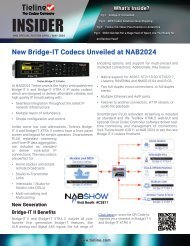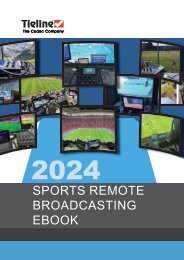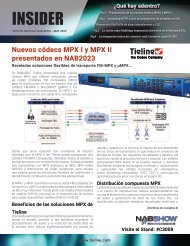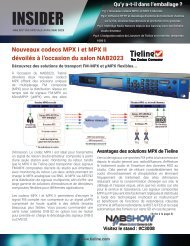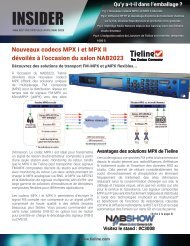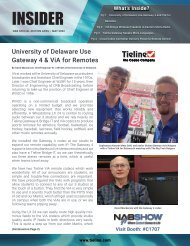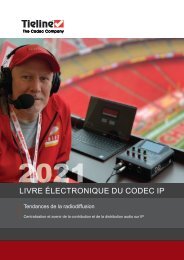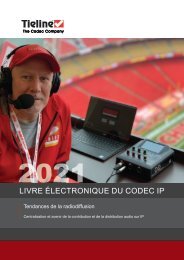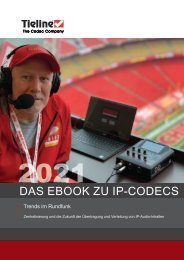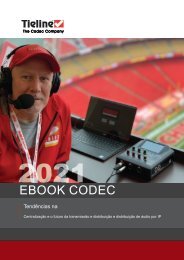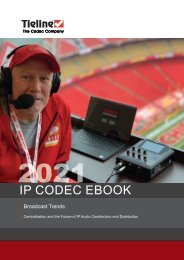Insider 2021 English
Create successful ePaper yourself
Turn your PDF publications into a flip-book with our unique Google optimized e-Paper software.
INSIDER<br />
Pg:1<br />
Pg:2<br />
Pg:3<br />
Pg:1<br />
What’s Inside?<br />
Neuhoff Media Consolidates Multiple Markets with<br />
Gateway<br />
Gateway Delivers AES67, ST 2110, NMOS & MUCH More…<br />
Gateway 4 Codec Provides New AoIP Options<br />
Pg:4<br />
Read How to Win a Bridge-IT Codec<br />
Neuhoff Media Consolidates<br />
Multiple Markets with Gateway<br />
By Kerri Cawley<br />
Kerri Cawley is IT Director/Contract Engineer for<br />
Neuhoff Media with a diverse engineering background<br />
in radio and TV facilities, and experience in IT. Kerri<br />
recently streamlined operations by consolidating 3<br />
markets and 12 stations into one backend facility in<br />
Springfield, IL.<br />
I recently designed new centralized network operations<br />
for Neuhoff Media with 4 stations in Springfield, 5<br />
stations in Decatur, and 3 stations in Bloomington.<br />
These markets cover most of central Illinois. Tieline<br />
Gateway codecs, Nexgen automation and Wheatstone<br />
AoIP are integral components of the setup.<br />
Gateway Setup<br />
We purchased Tieline’s Gateway 16 channel codec<br />
with a WheatNet-IP card for the studio to interface with<br />
our AoIP network. Its main purpose is to provide audio<br />
feeds for two of our markets - either direct to STLs,<br />
or to processing at the remote transmitter sites. We<br />
also installed a Gateway 8 channel codec at one of our<br />
transmitter sites in Decatur, which feeds our various<br />
RF STL feeds to the other sites. Backup Bridge-IT units<br />
at each site offer fail-over if the main site goes down.<br />
The Gateway codec’s high channel density was helpful<br />
in saving rack space and being able to integrate<br />
directly into our WheatNet AoIP network was a factor<br />
in deciding what codec to use. Having direct WheatNet<br />
routing from the codecs makes it much more efficient<br />
for studio connections and routing.<br />
I’ve handled most of the install and network design and<br />
integration of the codecs was fairly straightforward.<br />
Jacob and the Tieline crew in Indianapolis have been<br />
helpful when I had any questions. Overall, I’m pleased<br />
with the performance and reliability of the Tieline<br />
codecs and system generally.<br />
The Tieline Gateway below a Genie Distribution and Wheatstone Blades<br />
Site Connections<br />
At our studio we use a Comcast EDI fiber with secondary<br />
EPL connections to each market for feeding Wheatnet<br />
AoIP to remote studios. For the transmitter site feeds,<br />
DSL and wireless is used in our Bloomington market,<br />
as well as a couple of our sites in Decatur along with<br />
Comcast Business HFC connections. At a few of our<br />
transmitter sites internet connectivity can be an issue,<br />
but we have recently added an Airfiber link to our<br />
Bloomington market as our primary connection to the<br />
transmitter sites and Tieline codecs as a backup.<br />
Our fiber connections are very stable, as are the<br />
HFC connections. DSL and wireless can be a bit<br />
sketchy, which is why we opted for a Gateway and<br />
STL direct feeds from one of our main towers with<br />
a robust IP connection, with backup LTE. IP brings<br />
the flexibility of sending audio anywhere I need it,<br />
(Continued on Page 2)<br />
ENTER TO WIN!<br />
ENTER TO WIN!<br />
A Bridge-IT Codec<br />
See page 4 for details…<br />
www.tieline.com
INSIDER<br />
Pg:2<br />
compared to RF STL systems, where you’re limited<br />
by distance or obstructions. In this project, I combine<br />
the two technologies to make the path as reliable as<br />
possible. Without it this project wouldn’t be possible.<br />
I usually run AAC-LD 44k/256kbps with auto jitter<br />
buffering. It seemed to be the most reliable and low<br />
delay. I like to keep our feed delays to a minimum<br />
without having buffer underruns.<br />
Gateway Delivers AES67, ST 2110, NMOS & MUCH More…<br />
Tieline has specialized in IP streaming for nearly 2<br />
decades. After developing industry-leading cellular<br />
GSM, 3G, 4G, and 5G codec technologies, largely<br />
deployed at the remote end of connections, technology<br />
in the Gateway focuses on AoIP on the studio side.<br />
AES67 and ST 2110 at the Studio<br />
The Gateway is compliant with AES67 and SMPTE ST<br />
2110-30 for audio transport. These standards provide<br />
the framework for transporting uncompressed PCM<br />
audio around the broadcast plant. The AES67 and<br />
ST 2110-30 standards support Session Description<br />
Protocol (SDP) for configuring the number of audio<br />
Tieline’s Toolbox Web-GUI is ideal for configuration<br />
and control of codecs. It’s also convenient for doing<br />
firmware updates. All feeds are inside the network over<br />
site-to-site VPN for security, so nothing is exposed to<br />
the outside. I also use the Cloud Codec Controller, but<br />
haven’t set it up yet with all the sites. It nice to manage<br />
multiple codecs with one software program instead of<br />
opening a bunch of browser links.<br />
channels per stream, encoding format, bits per<br />
sample, sampling frequency and number of samples<br />
in a packet.<br />
As a result, Gateway and Gateway 4 codecs can stream<br />
AES67 digital IP audio between a range of equipment<br />
that won’t ordinarily connect using different protocols,<br />
but that support AES67. These devices would normally<br />
employ proprietary AoIP protocols for routing AoIP<br />
audio throughout a broadcast plant. However, in the<br />
real world broadcasters want to connect equipment<br />
from different vendors. Examples of proprietary AoIP<br />
protocols include WheatNet-IP, Livewire & Dante. This<br />
is where AES67 and ST 2110-30 provide minimum<br />
standards for communicating between devices from<br />
different AoIP vendors.<br />
No Discovery in AES67/ST 2110<br />
AES67 and ST 2110-30 only address stream transport,<br />
packet setup and synchronization (timing). Nothing is<br />
mandated regarding discovery.<br />
The Gateway AoIP codec supports connecting with proprietary AoIP protocols<br />
and using AES67/ST2110-30<br />
Gateway in Wheatstone’s Navigator software<br />
www.tieline.com
INSIDER<br />
Pg:3<br />
Tieline offers optional WheatNet-IP cards at purchase<br />
to interface directly with a WheatNet-IP network.<br />
Codecs then appear as Blades and seamlessly support<br />
discovery and control using Navigator software.<br />
Discovery & Control with NMOS,<br />
RAVENNA® and Ember+<br />
Gateway and Gateway 4 codecs are compliant with<br />
AMWA NMOS standards IS-04 and IS-05 which delivers<br />
the missing link: discovery, registration, and ultimately<br />
control for ST 2110 AoIP streaming. NMOS data<br />
models and open standard APIs deliver a new level of<br />
interoperability and control with networked equipment<br />
throughout the broadcast plant. More straightforward<br />
interoperability between products allows end users<br />
and service providers to build better systems.<br />
More NMOS and Ember+ features and capabilities will<br />
be developed over time and Tieline’s Gateways will<br />
continue to evolve and integrate new functionality via<br />
firmware updates.<br />
Multichannel Phase-Locked Options<br />
With demand for multichannel and surround sound<br />
streaming options increasing, up to 8 channels<br />
of digital phase-aligned multichannel audio are<br />
supported in Gateway to provide a range of flexible<br />
alternatives. Selectable options include 6 channel (5.1<br />
or 6.0), 8 channel (7.1 or 8.0), and 4 channel phasealigned<br />
audio streams.<br />
Tieline Gateway and Gateway 4 codecs now also<br />
support RAVENNA for discovery and control, to<br />
interface more easily over RAVENNA AoIP networks.<br />
The Gateway and Gateway 4 also support Ember+<br />
which is an openly available control protocol allowing<br />
equipment to interact more easily. Ember+ control<br />
software can easily manage devices from different<br />
manufacturers by integrating them into a single user<br />
interface.<br />
Gateway 4 Codec Provides New AoIP Options<br />
Tieline’s new Gateway 4 codec was released earlier<br />
this year and hundreds have already been shipped<br />
to broadcasters across the US and around the world.<br />
The Gateway 4 includes support for AES67, ST 2110-<br />
30, NMOS, Ember+, RAVENNA, AES3 and analog I/O<br />
as standard, and an optional WheatNet-IP card is<br />
available when purchased.<br />
IP Streaming Options<br />
The Gateway 4 has four channels and is ideal for<br />
transmitter sites, remote trucks or rack-mounted<br />
remote kits. It provides two stereo connections, or<br />
one stereo and two mono connections, or up to 4<br />
mono connections. The codec also supports multiple<br />
unicasting to up to 20 endpoints and multicasting.<br />
For affiliates and smaller stations, it is often used to<br />
transport studio-to-studio links, or a primary stereo<br />
STL path with a backup link, or an STL path can be<br />
combined with a stereo or dual mono remote links.<br />
Customers with higher channel requirements usually<br />
gravitate towards the Gateway multi-channel codec<br />
supporting up to 16 channels.<br />
The Gateway 4 codec<br />
Interoperability and Redundancy<br />
The Gateway 4 seamlessly integrates with all Tieline<br />
www.tieline.com
INSIDER<br />
Pg:4<br />
IP codecs and delivers hitless packet switching<br />
using SmartStream PLUS redundant streaming, plus<br />
bandwidth aggregation using Fuse-IP technologies<br />
over internet connections. The codec features dual<br />
internal power supplies, dual LAN ports and dual AoIP<br />
ports.<br />
Gateway 4 is interoperable with all Tieline IP codecs<br />
and compatible over SIP with all EBU N/ACIP Tech<br />
3326 and 3368 compliant codecs and devices. The<br />
Gateway 4 is configurable through an embedded<br />
HTML5 Toolbox Web-GUI interface and is also fully<br />
controllable using Tieline’s Cloud Codec Controller.<br />
Don’t miss test driving the Gateway and Gateway 4<br />
codecs during NAB<strong>2021</strong> at booth N3234. If you can’t<br />
make the show, email sales@tieline.com to request a<br />
personal test drive of the codecs via Zoom.<br />
Read How to Win a Bridge-IT Codec<br />
At NAB<strong>2021</strong> you will have the opportunity<br />
to WIN a FREE Bridge-IT codec simply by<br />
scanning your pass at the Tieline booth!<br />
Thousands of broadcasters around the world<br />
rely on Bridge-IT and Bridge-IT XTRA codecs for<br />
live broadcasts every single day. The codecs<br />
are ideal for affordable, high performance<br />
STLs and backup links over IP.<br />
How to Enter:<br />
1. Visit Tieline booth N3734 & scan your pass to<br />
win.<br />
2. Winner will be notified by SMS or Phone.<br />
Terms & Conditions:<br />
1. Dealers and Tieline staff ineligible. <br />
2. Prize is not redeemable for cash.<br />
3. One prize per person only.<br />
The team from Radio Alabama Won a Bridge-IT XTRA at NAB2019<br />
Bridge-IT and Bridge-IT XTRA are also perfect to install at<br />
the studio for low-cost remotes using Tieline’s Report-IT<br />
Enterprise app, or to connect to another Tieline codec.<br />
So don’t miss your opportunity to WIN and visit Tieline at<br />
NAB<strong>2021</strong> in the North Hall at booth N3734.<br />
Tieline America LLC<br />
7202 E. 87th Street, Suite #116,<br />
Indianapolis, IN 46256<br />
US Toll-free 1-888-211-6989<br />
Ph: 1-317-845-8000<br />
Fax: 1-317-913-6915<br />
E-mail: sales@tieline.com<br />
International<br />
Tieline Research Pty Ltd<br />
4 Bendsten Place<br />
Balcatta WA 6021 Australia<br />
Ph: +61-8-9413-2000<br />
E-mail: info@tieline.com<br />
www.tieline.com




